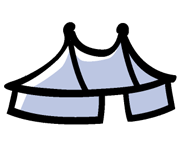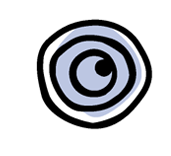AFP2 October 2009
Contemporary circus pulls out all the stops
 Contemporary circus often suffers from being the ’poor relation’ of live entertainment, but this autumn in Paris it will display its artistic vitality and diversity beneath the big top, in the form of Cirque Plume, which has been invited to La Villette, when the ’village circus’ comes to the Reuilly gardens.
Contemporary circus often suffers from being the ’poor relation’ of live entertainment, but this autumn in Paris it will display its artistic vitality and diversity beneath the big top, in the form of Cirque Plume, which has been invited to La Villette, when the ’village circus’ comes to the Reuilly gardens.
Originating from Franche-Comté, Cirque Plume is celebrating its 25th anniversary by presenting its ninth show until 20 December in the Parc de la Villette, entitled ’L’Atelier du peintre’ (the Artist’s studio).
It will encapsulate the flavour of ’new circus’ that has emerged as a result of a break from the traditional circus of la Zavatta, Grüss or Pinder: no place for wild animals here, no ring, but instead a highly elaborate thematic piece, in this case worked around painting.
The show, accompanied by live music, consists of impressive ’acts’ (juggling, trampoline, acrobatics, aerial straps, etc.) and none of the magic is lost. "It is the very essence of the circus, making the incredible possible, which means that we have to perform to the highest standard", said Bernard Kudlak, founder and artistic director of the company.
’L’Atelier du peintre’ does not provide a ’theatrical narrative’ but ’a poetic narrative that invites the spectator to move from one image to the next’, explained the producer. Cirque Plume brings us the gift of the moving image, which can be tender or funny, like the tableau with an odalisque that springs to life or the tightrope walker on a wire flying away like a witch on a broomstick.
The show is testimony to the healthy state of contemporary circus, which has broadened its repertoire with dance, theatre and plastic arts, but whilst keeping its popular dimension. "The circus has its roots deep in human mythology; it’s a kind of yearning for paradise, something we all share’, explained Bernard Kudlak.
Indeed Cirque Plume, which is one of the leading French companies in its field with 13 permanent cast members, attracts big crowds: its six previous shows were seen by a combined audience of nearly 1.5 million, on tours in France and abroad.
But the economics remain precarious, the venture being 84% self-financed (90% in the case of its last show). Broadly speaking, ’The circus is a poor relation, a very poor relation, when you look at the support given to the theatre or dance,’ says Bernard Kudlak.
Cirque Plume would like to receive a grant known as an ’aide au fonctionnement de la salle de spectacles’ towards the upkeep of its expensive big top, to which it is extremely attached. ’With the big top, the public come into performers’ own environment, the performers don’t go into a theatre, and it’s a venue that alters the structure of a town’, stresses Bernard Kudlak.
The 2r2c cooperative (’de rue de cirque’) is also in favour of ’companies that choose the big top as a way of life and defend that link with the public and creativity’. Like the pioneers of Cirque Baroque and the young artistes in the Compagnie Galapiat, who will hold a ’village circus’ on the lawns of Reuilly until 1 November.
"I’m not on an identity crusade, I’m quite happy for circuses to have fixed venues", says the man in charge of 2r2c, Rémy Bovis, referring in particular to the Cité internationale and Silvia-Monfort theatres in Paris.
’But it’s important to preserve the big top and the freedom to have one’s own performance space,’ he adds, whereas circus performers ’are finding it increasingly difficult to get into Paris and the big towns.’
Benoît Fauchet









